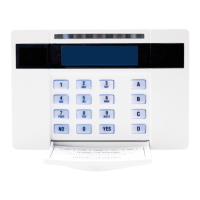EURO 46, 162 & 280 Programming Manual
Page: 15
Walk Test: The panel will not set if the user does not activate each detector with this attribute
after starting the setting timer. This is a way to prevent setting the system with masked or faulty
detectors.
Monitor Activity: This attribute works in conjunction with the NAT (Non Activity) timer. If a
detector has not been activated in during the NAT time the NAT output if programmed will be
activated. An event will be registered in the log too.
Special Log: Forces a log entry when the input is opened or closed, even when an alarm does
not result. May be selected to apply when a system is armed, when disarmed, or always.
Paired Input: For use in Grade 3 iD systems (or EoL inputs on peripheral devices fitted software
prior to version 5). Select to ‘YES’ for each of the two biscuits acting as the input. Fault Input:
Select to ‘YES’ for the biscuit acting as the ‘fault & anti-mask’ Paired With: For both biscuits
enter the input number with which each is paired.
Confirm Group: If one or more inputs are selected within the same confirm group, all confirmed
signals will be disabled. If confirm group is selected as ‘00’ the inputs are not part of any group.
If inputs are allocated to group 99 they will generate an alarm that results in an intruder
(unconfirmed) signal to an ARC. They will not under any circumstances generate a confirmed
signal, regardless of which group the input that selected the ‘unconfirmed’ alarm is allocated to.
4.6.4 Input Description
A name and location can be entered here. The name will appear on the display if an alarm has
occurred; the location is used for a more detailed reference if required.
Creating a Common Area
In some installations a ‘common’ area may be required. A common area is an area that only
arms, when other specific areas become armed.
Example: An entry and exit reception area in a building may only need to be armed if both the
offices and warehouse are armed.
If the office in Area A is armed, but the warehouse in Area B is still occupied, then the reception
would still need to be inactive so people would be able to leave the premises via the entry / exit
reception route.
One input can be allocated to one or more areas. In this example the inputs located in the
reception area will be programmed so that the reception inputs will be in Area A and Area B but
these inputs must have the Common input attribute programmed.
Area A: Office - Inputs = 3, 4, 5
Area B: Warehouse - Inputs = 6, 7, 8
Reception inputs – 1 and 2 are programmed into both Areas A and B, with the Common input
attribute programmed to both inputs.
The Reception Area inputs will now only become active if both Area A and Area B are both
armed.
Masking Response
When unset, a masking event will generate an audible “alert” that requires a response at the
keypad. There will be NO signal transmitted to the ARC. When set, a masking event will generate
an unconfirmed alarm but will NOT result in a confirmed alarm if paired with a normal activation
of the same detector. This harmonises with the requirement of EN50131-1 cause 8.4.5 and the
insurer’s preference expressed in BSIA Form 171.
Change Inputs Programming
1. Press or to scroll to 'CHANGE INPUTS'. Press .
2. Press or to select the input to program. Press .
3. 'Input Type' will be displayed. Press or to select the input
type or input the shortcut number (Refer to Appendix B (page 43))
for all input type options. Press
4. 'Input Area' will be displayed. Select the Area's to be assigned to
the input and press .
5. 'Input Attributes' will be displayed. If any attributes are needed for
the input, press and press or to select between the
attribute enable/disable options and press to go to the next
attribute.
CHANGE INPUTS?
Input [01]
Input 01
Input Type [07]
Final Exit

